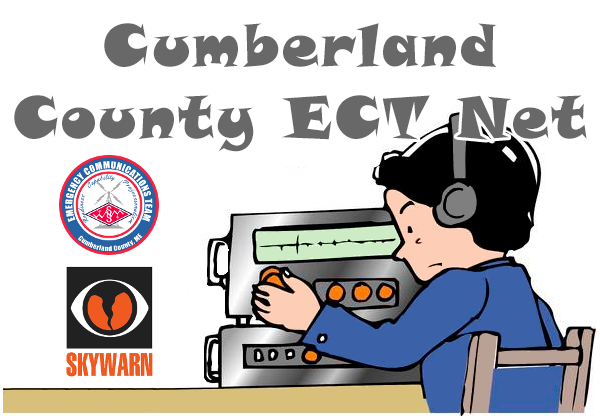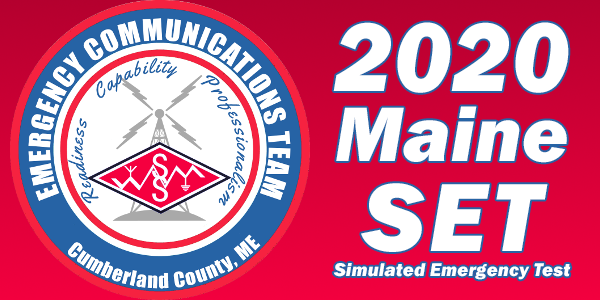On Saturday, October 24th, members of the Wireless Society of Southern Maine Emergency Communications Team (WSSM-ECT), which meets monthly in Scarborough, participated in a statewide drill to test their communications capabilities between various different sites throughout Cumberland County and the state. The drill, known as the Simulated Emergency Test, or SET, is an annual exercise, sponsored by the American Radio Relay League, which encourages amateur radio operators from across the country to test their communications skills during a mock disaster.
During the SET, hams are required to quickly establish communications between various Emergency Operations Centers and exchange formal messages and traffic, which contain requests for supplies, medical or weather reports, or other information that may be of importance during a disaster. They do this via voice and digital two-way radio, on bands ranging from HF to UHF, as required.
“There has been a lot of statewide coordination for this year’s event, and they’ve developed an extensive plan that involves testing both amateur radio and EMA communications,” says Tim Watson, of Saco. Watson is president of the Wireless Society of Southern Maine, which provides communications support to Cumberland County EMA, as well as the National Weather Service. “The SET tests how we respond during large-scale disasters, where commercial infrastructure has failed. In these events, hams are often called upon to provide communications support.”
“The hams in our club are a dedicated group,” adds Brad Brown, of Waterboro, “Amateur radio has a long history of volunteerism. Sure, it’s a hobby and there’s some fun things that we do, but so many like to stay sharp by providing support for community events, and drills like this, so they’ll be ready to offer their time and expertise when disaster strikes.”
The purpose of this year’s SET was to test the ability to communicate inter-county and between counties, using various modes: VHF FM repeater, VHF FM Simplex, HF SSB, VHF Packet, HF Digital, and Winlink via VHF Packet and HF Ardop.
Objectives included: Testing voice communications with other counties on amateur VHF repeaters, exchanging digital data with other counties on VHF repeaters, and the Maine Packet Network, testing voice communications with other counties on VHF Simplex, testing voice with other counties via HF, and exchanging digital traffic via HF. Each of these tasks were outlined in the 2020 Maine SET statewide plan. Other tasks were assigned to various EMA personnel to test their communications systems as well.
One of the most enjoyable parts of the 2020 SET was helping to relay a radiogram message from the York County EMA to Washington County. The message was originated in York and was relayed through several counties before reaching its destination. Steve Hansen KB1TCE reported afterwards that the message was delivered with near perfect accuracy. The only part that was missing in the final message was the signature. A possible reason for this is that the ARRL radiogram form has no place for a signature, compared with a Radio Relay International form, that does.
The SET scenario took place over 4 hours, from 8AM till noon, and as we approached the final hour, we decided to ask some of participants that checked in via FM simplex from their homes, to deploy to various shelter locations across the county. Eric Emery N1RXR visited Memorial Elementary School, in New Gloucester, Gray New Gloucester High School, in Gray, Greely Middle School, in Cumberland, Brunswick High School, and Falmouth High School, while Waylon McDonald KC1HJN was deployed to Windham High School and Gorham Middle School. We exchanged signal reports and exercise traffic from each location.
Brad Brown Jr., KC1JMH, was deployed to a strategic location on Chadbourne Ridge, in Waterboro, and acted as a VHF relay between York County to the south and the Cumberland County EMA.
Tim Watson KB1HNZ operated from the Cumberland County EMA. Do to COVID-19 restrictions, which limited the number of people in the building, he was the only ham operator at the EMA.
Lessons Learned
The WS1EC team successfully completed all but one task, which was to send digital traffic via FM Simplex. Having not been to the CCEMA in nine months, due to COVID-19 restrictions, one casualty was the Kenwood D710G VHF/UHF radio. After doing some trouble shooting to determine why it wouldn’t power on properly, the morning of the SET, it was determined that the best thing to do in the short window of time before the start of the exercise, was to use the backup radio, that was located in a backpack on a shelf in the radio room. The backup radio performed well and the programming was identical to the primary radio, so it was a seamless transition.
The only problem was discovering that there’s a difference in software settings between the D710A, and the newer D710G, which affected its ability to transmit when using Fldigi. This could’ve easily been fixed by downloading the appropriate RigCAT file, but in order to preserve the integrity of the SET, which listed among its scenarios, an internet outage, we chose not to update it at the time. In a future work session at the EMA, we plan on configuring the software to handle both radios, in case a failure happens again.
The Emergency Communications Team performed extremely well in this year’s SET, and many participants expressed a desire to do more exercises throughout the year, and more on-air training, like we did in the spring. In response, we’ll be starting up a training net again after the Holidays, to continue developing the skills necessary to perform at a high level.
Click here to view the WSSM-ECT After Action Report for the 2020 Maine SET.


